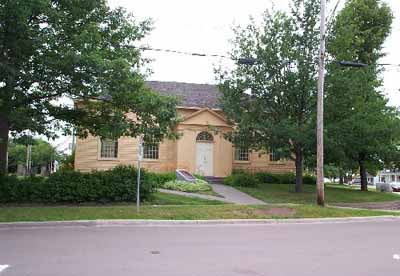Free Meeting House National Historic Site of Canada
Moncton, New Brunswick

Façade
© Parks Canada Agency / Agence Parcs Canada, 2008.
Address :
140 Steadman Street, Moncton, New Brunswick
Recognition Statute:
Historic Sites and Monuments Act (R.S.C., 1985, c. H-4)
Designation Date:
1990-06-22
Dates:
-
1821 to 1821
(Construction)
-
1821 to 1963
(Significant)
Event, Person, Organization:
Other Name(s):
-
Free Meeting House
(Designation Name)
Research Report Number:
1968-009, 1969-009, 1969-018, 1973-I, 1976-051B, 1990-022
Plaque(s)
Existing plaque: Mounted on stone monument near front door of house 140 Steadman Street, Moncton, New Brunswick
This meeting house is an eloquent witness to religious toleration in the Maritime Provinces. Constructed by members of the community, it was dedicated in 1821. As the only local place of worship, it was intended for use by all denominations and accommodated numerous congregations - Protestant, Roman Catholic and Jewish - until 1963. With the building's 1990 restoration as a Moncton centennial project, the meeting house resumed its historical role as a venue for special services held by various religious groups in the community.
Description of Historic Place
The Free Meeting House National Historic Site of Canada is a handsome, wood frame building whose exterior design reflects British classical influences, in its symmetrical elevation and classical details. The interior reflects historic meeting house designs, being an open hall with box pews. Located in downtown Moncton, the meeting house is now a historic site accessible to the public. The designation refers to the meeting house on its lot.
Heritage Value
The Free Meeting House was designated a national historic site of Canada in 1990 because: it is a symbol of the interdenominational religious toleration prevalent in the Maritime Provinces in the late 18th and early 19th centuries.
The heritage value of this site resides in its historical associations with religious toleration in the Maritime Provinces as illustrated by the location and design of the building. Originally constructed in the mode of a simple meeting house by members of the community, it was dedicated as a house of worship in 1821. As the only local place of worship, it was intended for use by all denominations and accommodated numerous congregations including Protestant, Roman Catholic and Jewish, until 1963. Over the years, the building was altered to respond to changing usage and taste but was restored in 1990 as a Moncton centennial project to approximate its 1821 condition. The Free Meeting House has resumed its historical role as a venue for special services held by various religious groups in the community.
Source: Historic Sites and Monuments Board of Canada, Minutes, November 1993.
Character-Defining Elements
Aspects of this site which contribute to its heritage character include: those features which speak to interdenominational religious toleration, specifically the early 19th-century meeting house design of the structure, including: the open interior hall with box pews and an elevated pulpit; the early 19th-century British classicism, shown in the symmetrical façade with a centre door, symmetrical side and rear elevations, sash windows, hipped roof, and classical detailing, all executed in wood; the single-storey volume reflecting the small size of the community; its relationship with its treed site, including the associated burial ground to the rear.